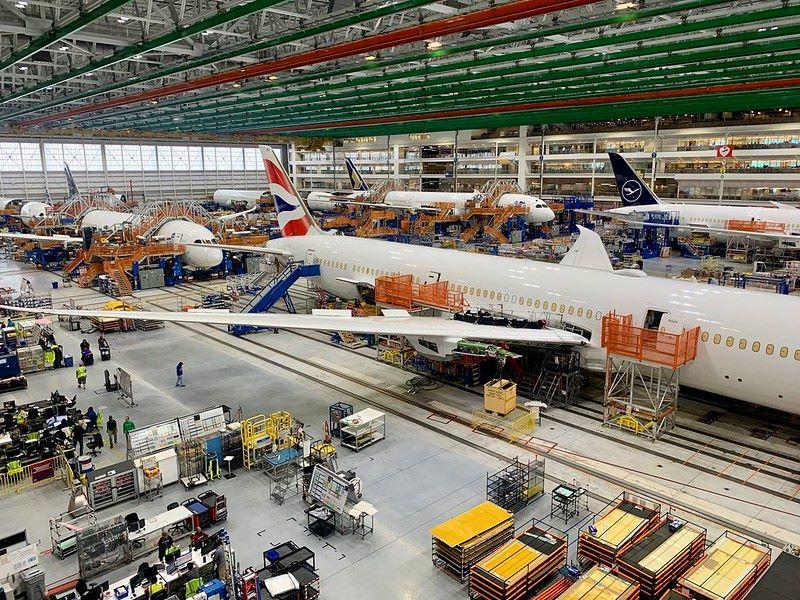
Global airlines will integrate nearly 44,000 new aircraft into their fleets over the next two decades, Boeing’s latest forecast finds, with widebodies taking a slightly larger share of the market than 2023’s projections expected while the regional jet segment continues to shrink.
Released on the eve of Farnborough Airshow, Boeing’s 2024 Commercial Market Outlook (CMO) projects 43,975 deliveries from 2024-2043. Not surprisingly, narrowbodies in the 90-plus-seat category dominate, with 33,380 deliveries or 76% of the market.
The figures reflect firmly established trends, including upgauging that is seeing larger and more tightly packed cabins used to add capacity but not flights. They also factor in near-term supply problems that are easing but will not disappear overnight.
“In general, the trend is definitely improving,” Boeing VP, Commercial Marketing Darren Hulst said in a briefing on the new forecast. “Will it all be fixed in a year? I think the answer is pretty unequivocally, no.”
A granular look at projected deliveries shows regional jets are slated to capture about 3.5%, or nearly one percentage point fewer than the 2023 forecast. Regional jets are steadily getting replaced by larger aircraft that offer not just more capacity, but better passenger experience through amenities such as multi-class cabins.
Conversely, widebody deliveries, projected at 8,065, picked up about 1% of share in the 2024 forecast compared to the previous year.
An uptick in widebodies reflects the need to serve the largest long-haul routes that connect major population centers.
“About 25% of long-haul seats are still on jets that carry 330 seats or more, which means that we need an efficient replacement for large, long-haul aircraft,” Hulst said. “These large markets aren’t going away. They may not grow as fast as emerging markets or point-to-point type markets, but they’re the largest markets in the world, and they need large aircraft in order to be satisfactorily connected.”
Similarly, long-haul single-aisle routes, while popular, will continue to complement widebody flying more than replace it.
Aircraft like the Airbus A321XLR, which has helped the European manufacturer take a sizable share of narrowbody orders in recent years versus the 737 MAX family and its comparable but still not certified 737-10, are too limited to be considered true widebody fleet disruptors, Hulst says.
“Single aisle has been in the market for close to 30 years,” he said, pointing to the 757’s debut on transatlantic routes in the mid-1980s. “It enables airlines to just take off a little bit more of that medium-haul and medium-long-haul [but] I just don’t think we’re going to see a wholesale change in how networks are constructed because of constraints around range [and] around payload.”
Near term, widebody demand also is set to increase as supply constraints such as delivery delays and lower-than-expected delivery rates—or, in the 777-9’s case, no deliveries at all—begin to ease. Boeing 787 deliveries have been lower than envisioned in recent years due to quality control challenges. The 777-9’s entry-into-service, currently slated for late 2025, will be several years late.
Getting both programs ramped up should make slight but measurable contributions to total long-haul delivery figures.
Several narrowbody programs, notably the 737 MAX, face similar supply constraints, but the projected size of the single-aisle market means their recovery—assuming it comes—will not be as noticeable over two decades.
Hulst estimated the recent production and delivery challenges have kept an estimated 2,000 aircraft out of the global fleet, cutting both growth and annual retirement rates. Operators and lessors have been removing about 1.5% of the annual fleet on average since 2020, which translates into about 400 aircraft based on the current environment. The historical figure is closer to the 3-3.5% range exhibited in the previous three decades.
“Capacity is constrained by the availability of new aircraft,” Hulst said. “Retirements are delayed as a result, because airlines need to provide capacity to the market, and so we’re seeing airlines find ways to provide that capacity in the absence of the amount of new aircraft that they need.”
Boeing’s outlook sees the global commercial jet fleet growing from 26,750 aircraft in 2023 to 50,170 in 2043. The changes factor in 20,555 deliveries, or 47%, replacing existing aircraft while 23,410 aircraft, or 53% of the projected new deliveries will be used for growth.
Boeing’s key 2024 forecast assumptions include average annual economic growth of 2.6% while passenger traffic as measured in revenue passenger kilometers will increase an average of 4.7% per year. The fleet will grow at about 3.2% per year, Boeing calculates.
In the services space, Boeing sees $4.4 trillion in total sales over the next two decades. Most of the revenues will be shared among three categories: parts distribution and services at 38%; MRO and conversions at 30%, and “digital solutions and analytics” at 28%. The remaining 4% will come from technical training—including pilots and mechanics—and related services.
Boeing will release a more detailed personnel forecast at the EAA AirVenture Oshkosh event July 22-28.
